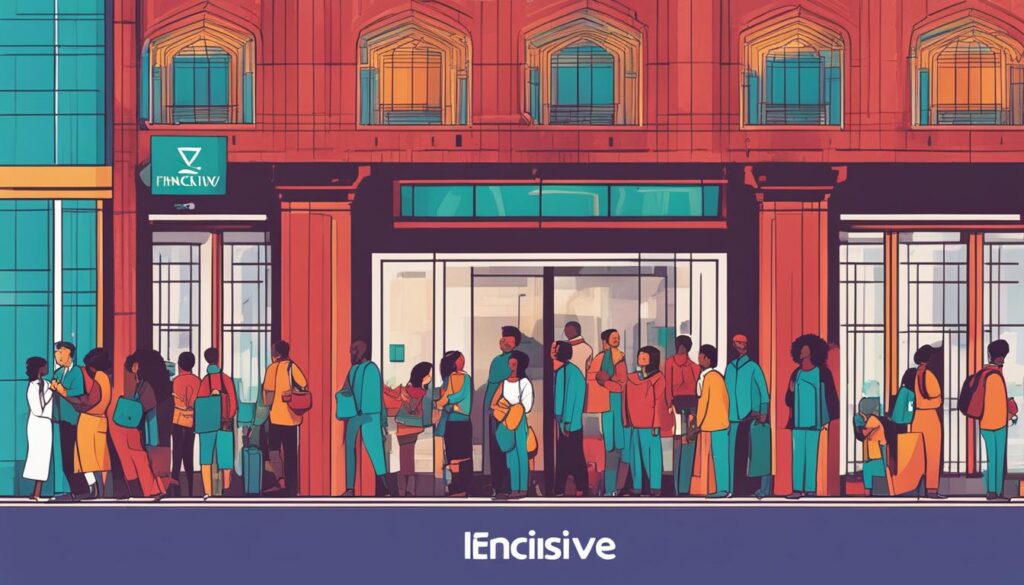As an advocate for inclusive financial services, I recognize the importance of affordable banking services and access to financial services for all individuals and businesses. That is why I am excited to discuss the various solutions that are improving financial inclusion through inclusive financial technology and innovative financial empowerment tools.
Table of Contents
ToggleKey Takeaways:
- Financial inclusion aims to make financial products and services accessible and affordable to all individuals and businesses.
- Advancements in fintech, such as digital banking solutions, play a significant role in improving financial inclusion.
- Financial inclusion is essential for providing financial access for all and improving the overall quality of people’s lives.
- Areas of financial inclusion encompass financial education, affordable banking services, addressing gender disparities, inclusive credit scoring, and consumer protection.
- Financial inclusion is important for reducing poverty, promoting economic growth, empowering marginalized demographics, driving innovation, and fostering digital inclusion.
What is Financial Inclusion?
Financial inclusion is an effort to make everyday financial services available to more people. It aims to provide access to savings, credit, and insurance, among other financial services, to improve people’s lives. It can encompass geographical, gender, age, or other marginalized groups.
Financial inclusion is a crucial step towards building a more inclusive and equitable society. By ensuring that everyone has access to essential financial services, we can empower individuals and enable them to better manage their finances, plan for the future, and achieve their goals.
Financial inclusion goes beyond simply providing access to financial products and services. It also involves addressing the barriers that prevent certain groups from participating fully in the financial system. These barriers can include limited physical access to financial institutions, lack of awareness and understanding about financial services, and discrimination based on gender or other factors.
Efforts to promote financial inclusion often involve the use of technology, such as mobile banking and digital payment platforms, to reach underserved populations and provide them with convenient and affordable financial services. Through these innovative solutions, individuals who were previously excluded from the formal banking system can now access a wide range of financial products and services, opening up new opportunities for financial growth and stability.
Inclusive finance is not just about providing access to financial services, but also about ensuring that these services are tailored to the unique needs and challenges of different groups. For example, inclusive finance initiatives may focus on offering microcredit to small business owners, providing financial education programs to empower individuals with the necessary knowledge and skills, or developing insurance products that protect vulnerable populations against unexpected risks.
Inclusive finance is about recognizing the diversity among individuals and communities and adapting financial services to meet their specific needs. It is an approach that embraces the principle that everyone should have the opportunity to participate in and benefit from the financial system.
Financial inclusion not only has a positive impact on individuals and households but also on the broader economy. By expanding access to financial services, countries can promote economic growth, reduce poverty, and strengthen financial stability. Moreover, financial inclusion can contribute to the achievement of several Sustainable Development Goals, including those related to poverty eradication, gender equality, and reduced inequality.
As we continue to work towards achieving greater financial inclusion, it is essential to collaborate across sectors and leverage technology to drive meaningful change. By combining the efforts of governments, financial institutions, fintech companies, and civil society organizations, we can create an enabling environment that promotes financial empowerment for all.
Financial inclusion is not just a goal; it is a fundamental right. By ensuring that everyone has access to essential financial services, we can help foster a more equitable and prosperous society for all.
How Financial Inclusion Works
Financial inclusion plays a vital role in improving the overall quality of life for individuals and businesses. By providing access to essential financial services, it enables people to manage their day-to-day expenses and plan for long-term goals. This section explores how financial inclusion works and the various services it encompasses, including savings, credit, insurance, and financial transactions.
Access to Financial Services
Financial inclusion ensures that individuals have access to a range of financial services that meet their specific needs. This includes services such as:
- Savings accounts: Enabling individuals to save money and build financial security for the future.
- Credit facilities: Providing access to credit that can be used for personal or business needs.
- Insurance products: Offering protection against unforeseen events and risks.
- Financial transactions: Facilitating payments, transfers, and other financial activities.
By having access to these services, individuals can better manage their finances, seize opportunities, and mitigate financial risks.
Promoting Financial Tools and Services
Financial inclusion not only provides access to financial services but also encourages individuals to utilize them effectively. By promoting tools such as:
- Savings programs: Encouraging individuals to save money regularly and build financial resilience.
- Credit options: Assisting individuals in accessing credit responsibly and managing their debt.
- Insurance coverage: Educating individuals about the importance of insurance and protecting their assets.
Through these financial tools and services, people can make informed decisions and enhance their financial well-being.
Financial inclusion empowers individuals and businesses by giving them the necessary tools and resources to achieve their financial goals. It breaks down barriers and ensures that everyone can actively participate in the economy.
Enhancing Financial Literacy
A key aspect of financial inclusion is promoting financial literacy and education. By providing individuals with the knowledge and skills to make informed financial decisions, they can maximize the benefits of available financial services. Financial literacy programs can cover topics such as:
- Budgeting and money management
- Understanding interest rates and loans
- Identifying investment opportunities
- Protecting against financial fraud
Through enhanced financial literacy, individuals can make informed choices, avoid financial pitfalls, and achieve greater financial security.
Benefits of Financial Inclusion
| Benefits | Description |
|---|---|
| Increased economic stability | Financial inclusion promotes economic stability by providing individuals and businesses with access to financial resources and opportunities for growth. |
| Reduced poverty and inequality | By removing barriers and offering financial services to all, financial inclusion helps reduce poverty and bridge income inequality gaps. |
| Improved financial well-being | Access to financial services allows individuals to effectively manage their finances, save for the future, and protect themselves from unexpected expenses. |
| Increased entrepreneurship and job creation | Financial inclusion enables aspiring entrepreneurs to access credit and necessary financial resources to start businesses, driving job creation and economic growth. |
Areas of Financial Inclusion
Financial inclusion encompasses various key areas that aim to promote equitable access and participation in the financial sector. These areas include:
1. Financial Education and Literacy
Financial education plays a crucial role in empowering individuals with the knowledge and skills necessary to make informed financial decisions. It equips people with the understanding of budgeting, saving, investing, and managing debt, enabling them to improve their financial well-being over the long term.
2. Affordable and Accessible Banking Services
Ensuring the availability of affordable and accessible banking services is essential for financial inclusion. This includes promoting the use of basic savings accounts, low-cost transaction services, and affordable credit options that cater to the needs of underserved populations.
3. Addressing Gender Disparities in Financial Services
Gender disparities in financial services are a significant barrier to achieving financial inclusion. It is essential to address these disparities by promoting equal access to financial resources, empowering women entrepreneurs, and providing targeted financial products and services designed to meet the specific needs of women.
4. Inclusive Credit Scoring Methods
Traditional credit scoring methods often exclude individuals with limited credit histories or unconventional income sources. Inclusive credit scoring methods, such as alternative data analysis and psychometric assessments, can help bridge this gap by providing more inclusive and accurate assessments of creditworthiness.
5. Consumer Protection in the Financial Sector
Consumer protection measures are crucial to safeguard the rights and interests of individuals accessing financial services. This includes robust regulations and policies that ensure fair and transparent practices, prevent predatory lending, and offer mechanisms for dispute resolution, ultimately building trust and confidence in the financial sector.
| Areas of Financial Inclusion | Key Considerations |
|---|---|
| Financial Education and Literacy | Providing accessible financial education programs and resources |
| Affordable and Accessible Banking Services | Promoting the availability of low-cost banking services |
| Addressing Gender Disparities in Financial Services | Empowering women through targeted financial products and services |
| Inclusive Credit Scoring Methods | Adopting alternative credit assessment methods |
| Consumer Protection in the Financial Sector | Implementing regulations for fair and transparent practices |
Importance of Financial Inclusion
Financial inclusion plays a pivotal role in addressing some of the most pressing social and economic challenges we face today. By ensuring that individuals and communities have access to affordable financial products and services, we can significantly reduce poverty and inequality, promote economic growth, empower marginalized demographics, support small businesses, drive innovation, and foster digital inclusion.
Poverty Reduction
Financial inclusion is a powerful tool in the fight against poverty. By providing individuals with access to inclusive financial services, such as savings accounts, credit, and insurance, we can help them build a secure financial future and escape the cycle of poverty.
Economic Growth
Access to financial services is essential for promoting economic growth. Financially inclusive economies have the opportunity to unlock the potential of small businesses, drive entrepreneurship, and create employment opportunities. When individuals and businesses have access to capital, they can invest, expand their operations, and contribute to the overall development of their communities.
Empowering Marginalized Demographics
Financial inclusion is particularly important for empowering marginalized demographics, such as women, rural populations, and minority groups. By removing barriers and providing equal access to financial services, we can create a more inclusive society where everyone has the opportunity to thrive and succeed.
Promoting Innovation
Financial inclusion encourages innovation in the financial sector. As more individuals gain access to financial services, it opens up new avenues for technological advancements, such as mobile banking, digital payments, and online lending platforms. This innovation not only benefits individuals but also contributes to the overall development of the financial ecosystem.
Digital Inclusion
In today’s digital age, digital inclusion is crucial for ensuring that no one is left behind. Financial inclusion goes hand in hand with digital inclusion, as it enables individuals to access financial services through digital platforms. By promoting digital literacy and expanding digital infrastructure, we can bridge the digital divide and create a more inclusive society.
Overall, financial inclusion is a powerful catalyst for positive change. It has the potential to transform lives, uplift communities, and drive sustainable development. As we continue to work towards greater financial inclusion, we can create a more equitable and prosperous future for all.

Financial Inclusion and Technology
Technology is revolutionizing the world of finance, playing a crucial role in advancing financial inclusion. With the increasing accessibility of smartphones and the internet, digital solutions have emerged to provide convenient and affordable financial services to individuals and businesses.
Mobile banking has been a game-changer, allowing users to access their accounts, make transactions, and manage their finances anytime, anywhere. This technology has significantly expanded financial access, particularly in remote or underserved areas where traditional banking services are scarce.
Digital payments have also gained momentum, empowering individuals to conduct transactions electronically, eliminating the need for cash. From online shopping to peer-to-peer transfers, digital payment solutions have made financial transactions more efficient and secure.
Agent banking has emerged as another innovative approach to financial inclusion. By leveraging technology, agents act as intermediaries, bringing banking services directly to communities that lack physical branches. This agent-based model has proven effective in extending financial services to underserved populations.
Furthermore, online lending platforms have democratized credit access by providing alternative lending opportunities for individuals and small businesses. These platforms utilize technology to connect borrowers with lenders, offering faster approval processes and more inclusive credit scoring methods.
Emerging technologies such as blockchain and cryptocurrency also hold immense potential for financial inclusion. Blockchain, with its decentralized nature and transparent ledger, enables secure and efficient transactions, while cryptocurrency provides an alternative digital currency for individuals who are unbanked or underbanked.
Technology-driven financial inclusion is transforming the landscape of financial services, making them more accessible, efficient, and inclusive. As technology continues to advance, we can expect further innovations that will empower individuals and communities, bridging the gap between financial services and the underserved.

The Impact of Technology on Financial Inclusion
| Technology | Benefits |
|---|---|
| Mobile Banking | Increased accessibility to financial services |
| Digital Payments | Efficient and secure transactions |
| Agent Banking | Brings banking services to underserved communities |
| Online Lending Platforms | Alternative credit access for individuals and small businesses |
| Blockchain | Secure and transparent transactions |
| Cryptocurrency | Alternative digital currency for the unbanked |
Pillar 1: National Financial Inclusion & Fintech Policy and Strategy
In order to achieve comprehensive financial inclusion, it is crucial to develop effective policies and strategies. This pillar focuses on conducting holistic assessments and formulating national financial inclusion and fintech policies to drive inclusive growth. By aligning policies with the needs of underserved populations, we can create an environment that fosters financial empowerment for all.
One of the key components of this pillar is conducting financial sector assessments to identify gaps and opportunities. These assessments provide valuable insights into the current state of financial inclusion and guide the development of targeted strategies.
In addition, implementing digital financial inclusion initiatives plays a vital role in expanding access to financial services. Leveraging fintech innovations, such as mobile banking and digital payments, enables greater reach and convenience, particularly for marginalized communities.
Benefits of National Financial Inclusion & Fintech Policy and Strategy:
- Enhanced access to affordable financial services
- Promotion of economic growth and stability
- Fostering innovation in the financial sector
- Reduced inequality and poverty
“By developing comprehensive national financial inclusion and fintech policies, we can create an enabling environment that supports inclusive growth and drives economic empowerment for all.” – John Financial, Director of Financial Strategies
| Key Objectives of Pillar 1 | Actions |
|---|---|
| Develop national financial inclusion policies | 1. Conduct in-depth research and analysis on existing policies 2. Engage with stakeholders to gather insights and feedback 3. Formulate inclusive policies that address the needs of underserved segments |
| Conduct financial sector assessments | 1. Assess the current state of financial inclusion 2. Identify gaps and opportunities for improvement 3. Analyze the impact of fintech innovations on financial inclusion |
| Implement digital financial inclusion initiatives | 1. Promote digital payment systems and mobile banking services 2. Facilitate partnerships between financial institutions and fintech providers 3. Enhance digital literacy and awareness among underserved populations |

Implementing policies and strategies outlined in this pillar is a crucial step towards achieving financial inclusion at a national level. By leveraging fintech innovations and focusing on the needs of underserved segments, we can build a more inclusive financial ecosystem that empowers individuals and fosters sustainable economic growth.
Pillar 2: Financial Products and Providers for Underserved Segments
As part of the comprehensive approach to achieve financial inclusion, Pillar 2 focuses on addressing the needs of underserved segments through policy reforms that benefit specific demographics, such as women and rural populations. The goal is to expand the range of appropriate financial products and services and enable the entry of innovative providers into these segments.
By identifying the unique challenges and requirements of underserved populations, financial inclusion can be enhanced through tailored solutions. This pillar recognizes that traditional financial products and providers may not adequately serve the needs of these segments and seeks to foster a more inclusive environment.
One approach is to develop innovative products that cater to the specific financial needs of underserved populations. For example, microfinance institutions have been successful in providing access to credit for individuals with limited resources, helping them start small businesses and improve their livelihoods.
“Innovative financial products play a critical role in bridging the gap between the underserved segments and mainstream financial services.”
Furthermore, enabling the entry of innovative providers can significantly contribute to improving financial inclusion. Fintech startups, for instance, leverage technology to create innovative solutions that are affordable and accessible to underserved populations. By harnessing the power of mobile apps, digital platforms, and agent networks, these providers bring financial services closer to those who lack traditional banking infrastructure.
Table:
| Financial Products for Underserved Segments | Innovative Providers |
|---|---|
| Microfinance | Fintech startups |
| Community-based savings groups | Mobile banking platforms |
| Rural agricultural credit | Agent banking networks |
| Social impact bonds | Online lending platforms |
Pillar 3: Financial Consumer Protection
Financial consumer protection plays a crucial role in ensuring that financial inclusion benefits consumers and safeguards their interests. This pillar focuses on key areas that promote transparency, fair treatment, and market conduct supervision within the financial sector.
Market Conduct Supervision
Market conduct supervision refers to the oversight and regulation of financial institutions to ensure they adhere to ethical practices and comply with consumer protection policies. It involves monitoring market behavior, detecting and addressing misconduct, and enforcing appropriate disciplinary measures when necessary.
Disclosure and Transparency
Disclosure and transparency are essential in providing consumers with access to clear and accurate information about financial products and services. It involves ensuring that consumers have comprehensive details on fees, terms, and any potential risks associated with their financial decisions. Transparent disclosures empower consumers to make informed choices and protect them from misleading practices.
“Transparency is key in building trust between financial institutions and consumers. By ensuring clear and accurate disclosure of information, we promote a fair and transparent financial landscape, fostering confidence and empowering consumers.”
Fair Treatment and Business Conduct Regulation
The pillar of fair treatment and business conduct regulation aims to prevent unjust practices and ensure consumers are treated fairly by financial institutions. It involves the implementation of regulatory frameworks that protect consumers from unethical behaviors, discriminatory actions, and unfair contract terms. By upholding fair treatment standards, this pillar strengthens consumer trust and enhances market integrity.
Table: Overview of Financial Consumer Protection Pillar
Pillar 4: Financial Capability and Behavioral Insights
In order to enhance financial inclusion, it is crucial to focus on developing the financial capability of individuals and leveraging behavioral insights. By improving financial education and literacy, individuals are empowered to make informed financial decisions, bridging the gap and ensuring access to financial services for all.
Through strategic approaches to financial capability, we can equip individuals with the necessary knowledge and skills to navigate the complex financial landscape. This includes providing training programs, workshops, and resources that promote a better understanding of financial concepts, budgeting, and saving.
Behavioral insights offer valuable perspectives on human behavior and decision-making. By understanding how individuals think and make choices when it comes to financial matters, we can design more effective interventions and tools that cater to their unique needs and preferences.
“Individuals are not always rational decision-makers when it comes to finances. Behavioral insights help us identify the barriers and biases that influence their choices, enabling us to design interventions that align with their behaviors and drive positive financial outcomes.”
Financial Capability Interventions
Financial capability interventions go beyond providing basic financial education. They focus on building long-term financial resilience and well-being. These interventions could include:
- Interactive online courses on budgeting, loans, and savings
- Personalized financial coaching and mentorship programs
- Referral services to connect individuals with relevant resources and assistance
- Innovative financial tools and apps that promote saving and financial goal-setting
Behavioral Insights in Action
Behavioral insights can be applied to promote positive financial behaviors and improve financial inclusion. Examples of how behavioral insights can be leveraged include:
- Using simple and actionable messages to encourage savings and responsible spending
- Designing user-friendly interfaces for digital banking platforms to enhance accessibility
- Implementing default options for enrollment in beneficial financial services
- Providing real-time feedback and nudges to prompt positive financial habits
By combining financial capability interventions with behavioral insights, we can create a powerful framework for achieving true financial inclusion. Individuals will be better equipped to make sound financial decisions, maximize their financial well-being, and contribute to overall economic growth and stability.
| Benefits of Financial Capability Interventions and Behavioral Insights | Examples |
|---|---|
| Improved financial decision-making | Interactive online courses on budgeting and investing |
| Increased savings and asset accumulation | Personalized financial coaching and mentorship programs |
| Reduced reliance on high-cost borrowing | Innovative financial tools that encourage responsible borrowing |
| Enhanced financial resilience and well-being | Real-time feedback and nudges to promote positive financial habits |
Pillar 5: Micro, Small, and Medium Enterprise (MSME) Finance
As we delve deeper into the pillars of financial inclusion, we cannot overlook the crucial role of Micro, Small, and Medium Enterprises (MSMEs) in the economy. This pillar focuses on supporting policymakers in monitoring and improving access to credit for MSMEs, which are vital contributors to economic growth and employment opportunities.
Financial inclusion is essential to empower MSMEs, enabling them to access the necessary capital and resources for sustainable development. By facilitating MSME finance, we can lay the foundation for fostering innovation, job creation, and overall economic prosperity.
Market Diagnostics: Identifying Risks and Gaps in MSME Finance
To facilitate effective MSME finance, it is imperative to conduct comprehensive market diagnostics. This process involves analyzing market conditions, identifying existing risks and gaps, and determining areas for improvement. By gaining a deep understanding of the challenges and opportunities in MSME finance, policymakers and stakeholders can develop targeted strategies and initiatives to address these gaps.
Market diagnostics can shed light on various aspects of MSME finance, such as access to credit, loan affordability, interest rates, collateral requirements, and financial products tailored to the specific needs of MSMEs. It helps identify barriers that hinder MSMEs’ ability to obtain financing from traditional financial institutions and paves the way for innovative solutions.
Supply-Side Analysis: Strengthening Access to Credit for MSMEs
Supply-side analysis plays a vital role in improving access to credit for MSMEs. It involves assessing the availability, affordability, and suitability of financial products and services offered by financial institutions and alternative providers. By evaluating the supply-side dynamics, policymakers can identify bottlenecks or inefficiencies and implement measures to enhance the credit ecosystem.
This analysis encompasses various factors, including the capabilities and capacity of financial institutions, lending practices, risk management frameworks, and credit evaluation mechanisms. It also considers the role of technology, such as digital lending platforms, in bridging the credit gap for MSMEs.
Inclusive and accessible credit for MSMEs is vital for driving entrepreneurship, job creation, and economic growth.
The supply-side analysis is informed by collaboration among regulators, financial institutions, non-governmental organizations, and other stakeholders. By fostering communication and knowledge-sharing, we can create a robust financial ecosystem that supports the growth and development of MSMEs.
Through market diagnostics and supply-side analysis, policymakers can gain insights into the specific challenges faced by MSMEs in accessing finance. This knowledge serves as a foundation for formulating targeted policies, implementing innovative financial solutions, and facilitating an enabling environment for the growth of MSMEs.

By ensuring that MSMEs have access to affordable credit, we can unleash their potential and drive inclusive economic growth. The pillars of financial inclusion, including MSME finance, work together to build a financial ecosystem that empowers individuals, businesses, and communities.
Conclusion
Financial inclusion solutions are essential for fostering a fair and equitable society. By harnessing the power of technology and focusing on key pillars such as policy, products and providers, consumer protection, financial capability, and MSME finance, we can make significant strides towards achieving greater financial inclusion and empowering individuals and communities with essential financial tools.
The future of financial inclusion holds immense potential for innovation and positive change. As we continue to leverage technology, such as digital banking solutions and inclusive fintech, we can revolutionize the way financial services are accessed and utilized. This will not only break down barriers and provide greater access to inclusive financial services but also enhance financial empowerment and improve the overall quality of life for individuals around the world.
It is crucial that we continue to prioritize financial inclusion and work together to bridge the gap in access to financial services. By implementing comprehensive solutions and addressing the needs of underserved populations, we can pave the way for a future where everyone has equal opportunities to thrive economically. Achieving financial inclusion is not only a matter of social justice but also a catalyst for sustainable economic growth and development.
FAQ
What is financial inclusion?
Financial inclusion refers to efforts to make financial products and services accessible and affordable to all individuals and businesses, promoting economic growth and innovation.
How does financial inclusion work?
Financial inclusion provides access to savings, credit, insurance, and other financial services, improving people’s lives and enabling them to plan for their long-term goals.
What are the areas of financial inclusion?
Financial inclusion encompasses financial education, affordable banking services, addressing gender disparities, inclusive credit scoring, and ensuring consumer protection.
Why is financial inclusion important?
Financial inclusion reduces poverty and inequality, promotes economic growth, empowers marginalized demographics, supports small businesses, drives innovation, and fosters digital inclusion.
How does technology contribute to financial inclusion?
Technology, such as mobile banking, digital payments, agent banking, online lending platforms, blockchain, and cryptocurrency, makes financial services more accessible and convenient.
What is the National Financial Inclusion & Fintech Policy and Strategy?
This pillar focuses on developing national financial inclusion and fintech policies, conducting financial sector assessments, and implementing digital financial inclusion initiatives.
How does financial inclusion support underserved segments?
This pillar supports policy reforms specific to financial products and providers, expanding the range of appropriate products and enabling the entry of innovative providers.
What is financial consumer protection?
Financial consumer protection ensures that financial inclusion benefits consumers and includes areas such as market conduct supervision, disclosure and transparency, and fair treatment regulation.
What is financial capability and behavioral insights?
This pillar emphasizes the importance of financial capability and includes interventions to improve financial education and literacy, support strategic approaches, and use behavioral insights.
How does financial inclusion support Micro, Small, and Medium Enterprises (MSME) finance?
This pillar focuses on monitoring and improving access to credit for MSMEs, conducting market diagnostics, identifying risks and gaps, and facilitating communication among stakeholders.











